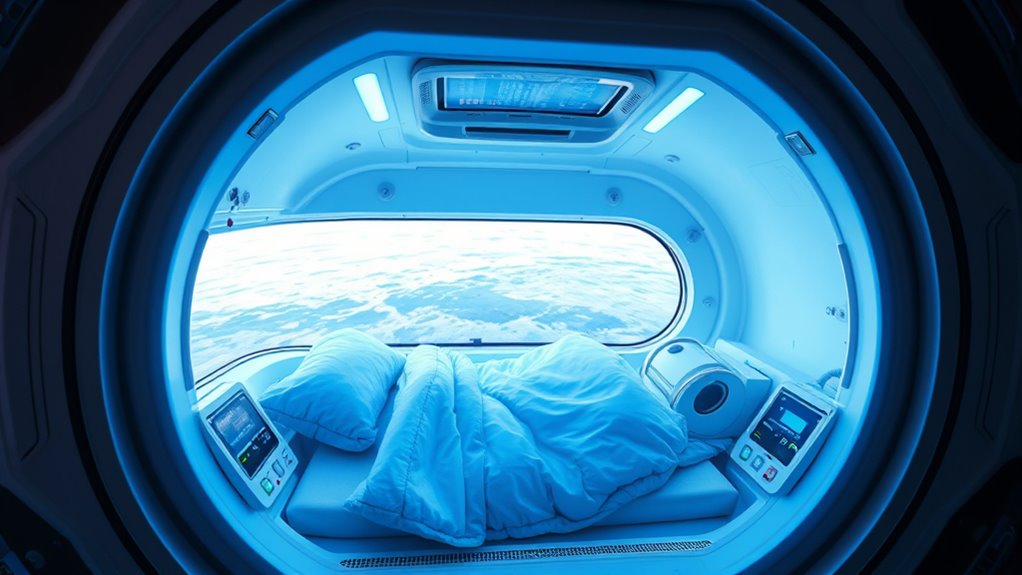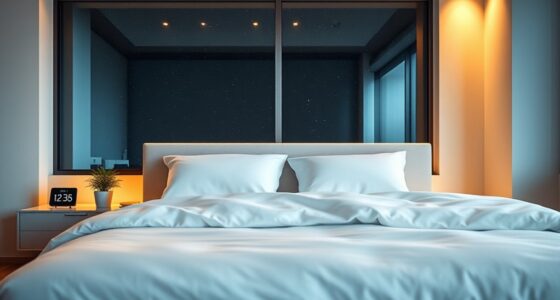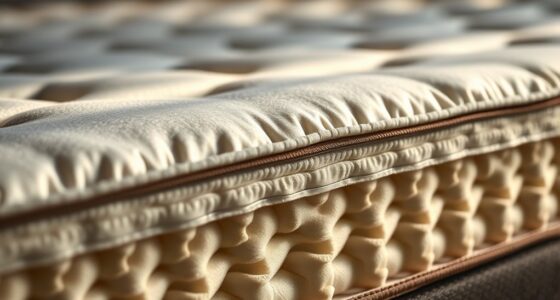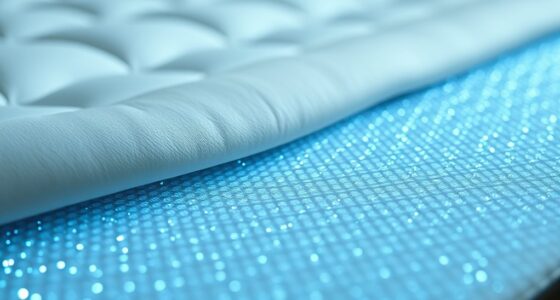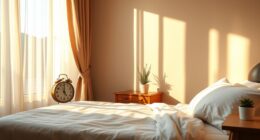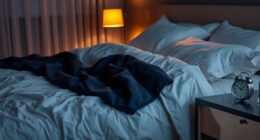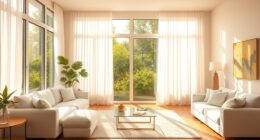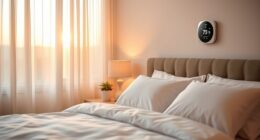NASA uses innovative sleep tech like adaptive bedding that molds to your body, and gravity boots to help astronauts stay anchored in space. They also deploy soundproof chambers and noise-canceling systems to block out spacecraft noise, making sleep more peaceful. Advanced sleep monitors track your rest, while temperature and light controls create ideal conditions. If you want to discover how these space-age solutions can transform your sleep, keep exploring the exciting possibilities ahead.
Key Takeaways
- NASA uses adaptive bedding and gravity boots to simulate Earth’s gravity, improving sleep stability in zero-gravity environments.
- Soundproof chambers and noise-canceling tech create quiet, Earth-like sleep conditions aboard spacecraft.
- Advanced sleep monitoring devices track astronauts’ rest patterns to personalize sleep schedules and enhance quality.
- Precise temperature regulation systems maintain consistent comfort through specialized mattresses and heat-dispersing nanotubes.
- Innovations like smart sleep masks and climate-controlled bedding from space tech are paving the way for improved home sleep solutions.
Zero-Gravity Sleep Environments and Adaptive Bedding
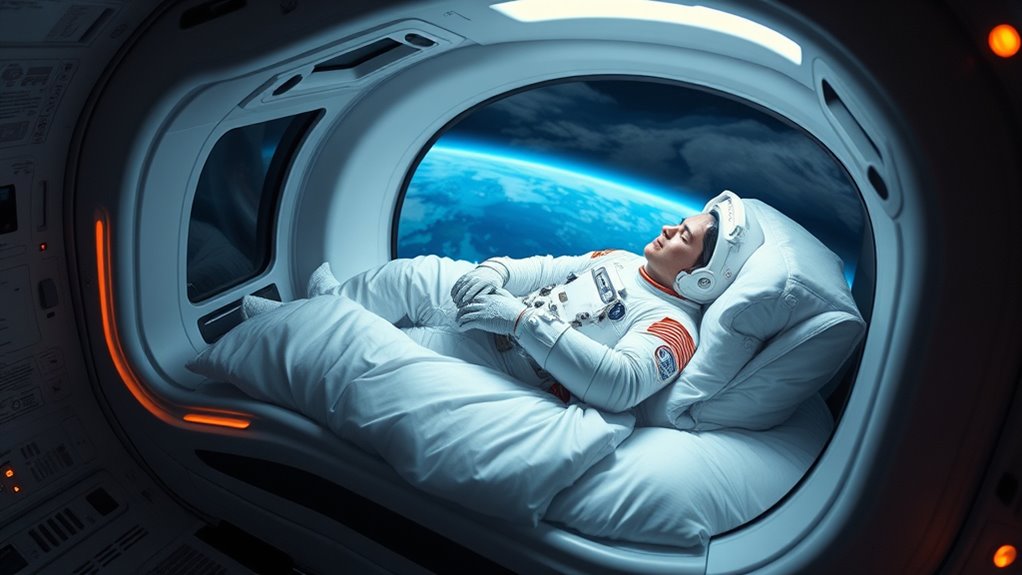
Since astronauts experience weightlessness in space, traditional beds don’t work effectively. Without gravity, you float freely, making it hard to find rest and risking sleep deprivation. NASA uses gravity boots to help astronauts anchor themselves, providing stability and a sense of orientation. These boots enable astronauts to secure themselves during rest periods, reducing disorientation and improving sleep quality. Adaptive bedding is also designed to mold to the astronaut’s body, preventing movement and discomfort in zero gravity. This combination of gravity boots and specialized bedding creates a more comfortable, sleep-friendly environment. By mimicking some aspects of Earth’s gravity, NASA helps astronauts avoid sleep deprivation, ensuring they stay alert and healthy during their missions. Incorporating personal comfort strategies can further enhance sleep quality in challenging environments.
Soundproof Chambers and Noise-Canceling Technology
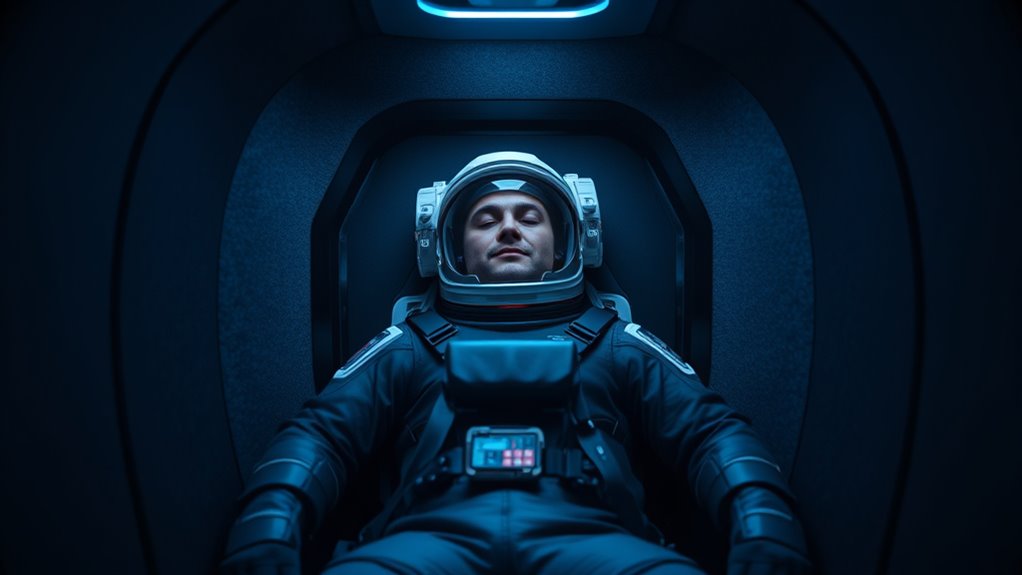
To guarantee astronauts get restful sleep despite the noisy environment of space, NASA employs soundproof chambers and noise-canceling technology. These soundproof chambers are specially designed to block out the constant hum of equipment and other spacecraft sounds, creating a quiet haven for rest. Noise-canceling technology actively reduces ambient sounds by emitting sound waves that counteract noise, making it easier for astronauts to relax. This combination helps simulate a peaceful, Earth-like sleep environment in the vacuum of space. By minimizing disruptive noises, NASA ensures astronauts can fall asleep faster and stay asleep longer, which is essential for their health and mission performance. These innovations highlight how advanced soundproofing and noise reduction techniques can transform sleep quality, both in space and at home.
Sleep Monitoring and Personalized Rest Data
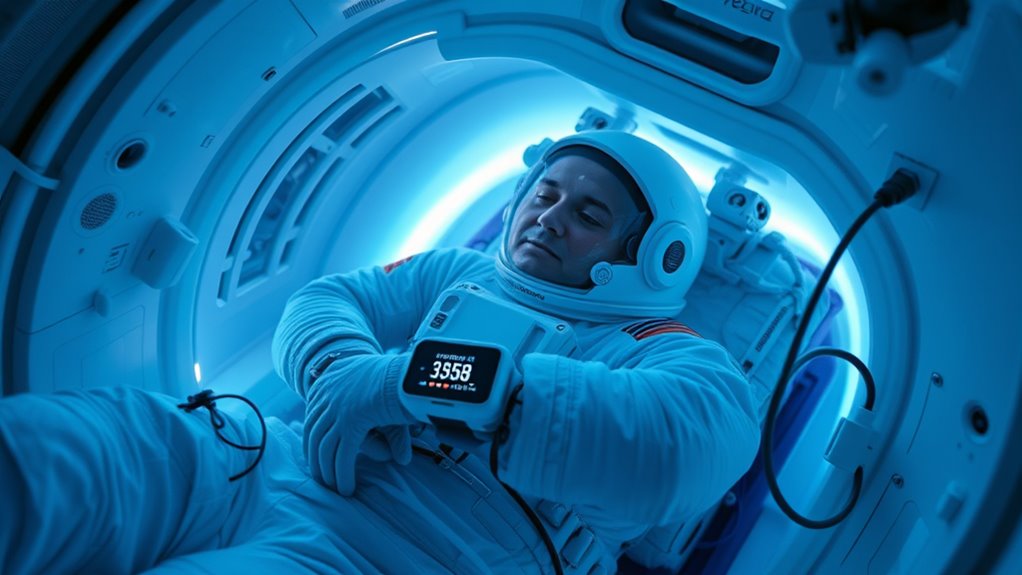
Ever wondered how astronauts optimize their sleep in the demanding environment of space? NASA uses advanced sleep monitoring to gather personalized rest data, helping astronauts improve sleep quality. This tech tracks various metrics like sleep duration, cycles, and disturbances. With this data, astronauts and mission control identify issues and adjust routines for better rest. Here’s how it works:
- Wearable sleep trackers monitor real-time sleep patterns
- Data analysis reveals trends and disturbances
- Customized sleep schedules optimize rest periods
- Feedback loops refine strategies for better sleep quality
- Incorporating emotional triggers can further enhance relaxation and sleep effectiveness
This approach ensures astronauts get the rest they need, even in space’s challenging environment. The insights from sleep tracking and rest optimization not only benefit space missions but can also help you improve your sleep habits at home.
Temperature Regulation and Light Control Systems
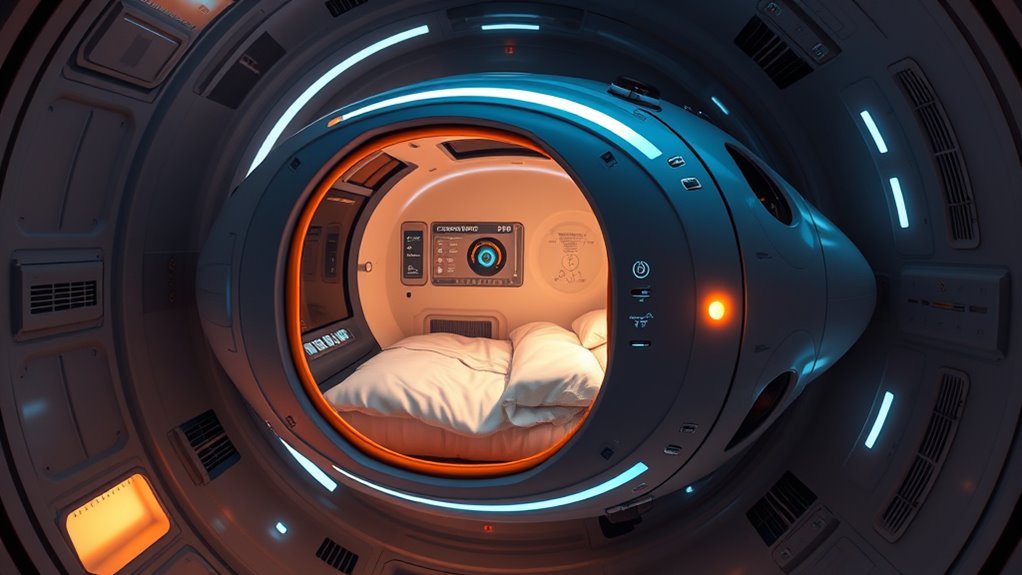
Maintaining ideal sleep conditions in space relies heavily on precise temperature regulation and light control systems. NASA uses advanced technology like specialized space mattresses and sleep nanotubes to achieve this. The space mattress is designed to provide uniform comfort and temperature, preventing hot or cold spots that could disturb sleep. Sleep nanotubes help regulate temperature at a microscopic level, dispersing heat efficiently and maintaining a consistent environment. Light control systems simulate Earth’s day-night cycle, adjusting brightness and color to help astronauts synchronize their circadian rhythms. These systems work together to create a stable, comfortable sleeping environment in the weightless conditions of space, ensuring astronauts get rest essential for their health and mission performance. This innovative approach could soon influence how you manage sleep at home. Additionally, understanding IRA investment strategies can help retirees optimize their income and plan for tax implications.
Future Innovations and Potential Home Applications
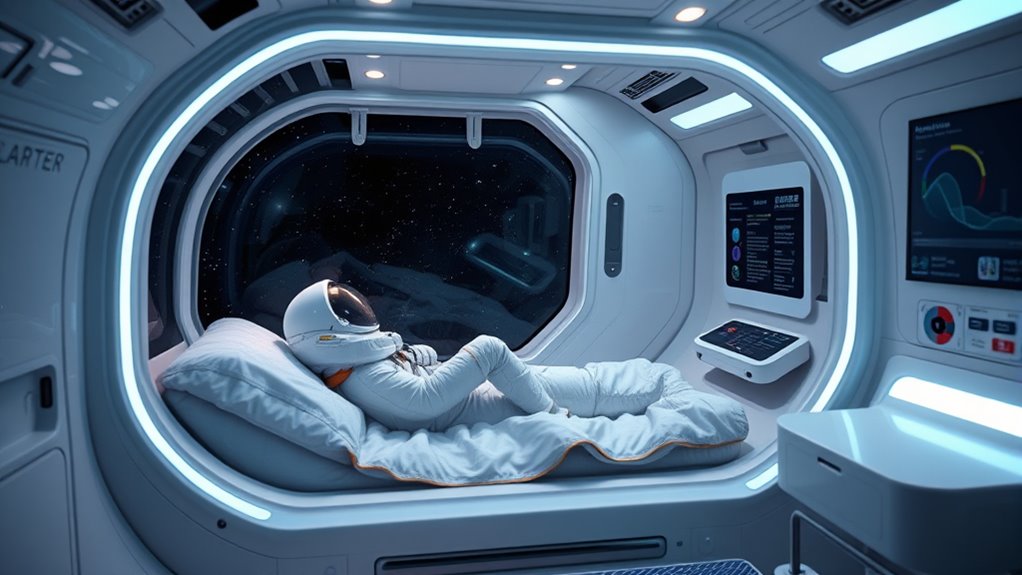
As space technology advances, many of these innovations are beginning to find their way into homes, promising to revolutionize how you sleep. Future innovations like space-grade sleep aids could improve your rest by mimicking the conditions used in astronaut sleep experiments. These devices may include advanced sleep masks, personalized sleep environments, and adaptive lighting systems. Here are some exciting possibilities:
- Enhanced sleep masks with biofeedback sensors
- Climate-controlled bedding inspired by spacecraft systems
- Light therapy devices tailored for optimal circadian alignment
- Smart sleep systems integrating astronaut sleep experiment data for personalized routines
- Incorporating sleep hygiene practices from space research can further optimize your sleep quality.
Frequently Asked Questions
How Do Astronauts Adapt to Sleeping in Space’s Altered Gravity?
In space, microgravity adaptation affects how you sleep, as your body doesn’t feel gravity’s pull. To manage this, astronauts use specialized sleeping bags and harnesses to stay in place, helping regulate their sleep cycles. These tools prevent floating and discomfort, making it easier to fall asleep and stay asleep. By maintaining a consistent sleep routine and using these adaptations, astronauts can better regulate their sleep cycles in microgravity.
What Materials Are Used in Nasa’S Adaptive Bedding for Comfort?
NASA’s adaptive bedding uses space-grade fabrics that withstand the rigors of space and provide comfort. You’ll find memory foam incorporated to contour to your body, offering support and pressure relief. This combination guarantees a restful sleep, even in microgravity. The materials are lightweight, durable, and designed to accommodate your movements, making your sleep environment more comfortable and helping you stay refreshed during space missions.
How Accurate Are Nasa’S Sleep Monitoring Devices Compared to Consumer Tech?
You might wonder about the accuracy of NASA’s sleep monitoring devices compared to consumer tech. NASA’s devices are highly precise, designed for detailed sleep quality analysis in space, often surpassing typical consumer gadgets. They track subtle data like brain waves and physiological signals, giving you reliable insights. While consumer tech is improving, NASA’s specialized devices still lead in device accuracy, offering more all-encompassing sleep data that can help improve your rest.
Can Nasa’S Temperature and Light Control Systems Be Adapted for Home Use?
You can definitely adapt NASA’s space temperature and light control systems for home use. These systems regulate space temperature and mimic natural light cycles, so you can improve your sleep and mood with better light therapy and climate control. By integrating smart thermostats and circadian lighting, you create a more comfortable environment that supports your sleep patterns, just like astronauts experience in space, but tailored for your everyday needs.
What Are the Biggest Challenges in Translating Space Sleep Tech to Everyday Environments?
Think of adapting space sleep tech like fitting a spaceship’s controls into your car’s dashboard. The biggest challenge lies in space habitat design, which prioritizes extreme conditions and efficiency. You need to match astronaut sleep schedules to Earth’s rhythms, but space systems are complex and costly. Translating this tech means balancing innovation with practicality, ensuring it’s safe, affordable, and user-friendly for everyday environments.
Conclusion
Imagine bringing NASA’s mind-blowing sleep tech into your own home—your nights could be transformed into the most restful, futuristic experience ever. Zero-gravity beds, soundproof chambers, and personalized sleep data might sound like sci-fi, but they’re closer than you think. Soon, you’ll be sleeping like an astronaut on the moon, waking up energized and ready to conquer anything. The future of sleep is here, and it’s more incredible than you’ve ever dreamed!
